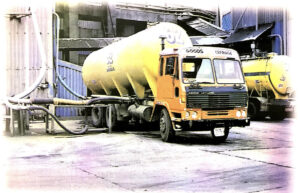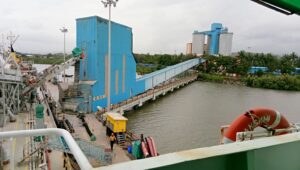The storage of bulk cement is an essential link in the cement processing industry. There are many ways to store cement, but the best way for long term storage is by using cement silos.
The cement silos have the characteristics of good uniformity in the cement storage section. With the increase of storage time of the cement, the storage density of cement increases, which means that the cement will be basically sealed by vacuum in the air-tight storage. The sealing effect is much better or effective than other storage containers such as storage bags.
Bulk Storage of Cement
Bulk storage of cement is always preferable to bagged storage. The storage of bulk cement is generally done in silos. Most of the modern batching mixing plants have steel silos that store bulk cement. However, smaller portable silos for storing bulk cement can also be used for concrete production by the conventional method using a mixer.
Bulk storage of cement has following advantages:
- Cement unloading is done automatically utilizing the blower installed on the bulker truck. Compressed air from the blower fluidizes the cement and it is blown into the silo. Labour is not required to unload cement as in the case of bagged cement.
- Cement received at the site first must be consumed first. It is difficult in the case of bagged cement to follow this system as an often proper record or stacking is not done as a result the fresh stock of bags dumped on existing old stock often lie unused for a longer period. In the case of bulk cement stored in the silos old stock is automatically utilized first from the silo bottom and fresh stocks are added at the top.
- The packing cost is saved and chances of cement hydration during transportation and during storage are reduced considerably. Bulk cement trucks and storage silos at the site are generally air and watertight and hence cement hydration is unlikely.
- The system is clean and environmentally friendlier than the conventional system using bagged cement.
- Chances of adulteration or pilferage are also reduced.
- In a modern batching mixing plant has a very high output, manual cement loading using bagged cement often becomes a bottleneck and causes a reduction of plant output. Since bulk cement loading is more efficient and less labor-oriented, the batching plant can work more efficiently.

Bulk Transportation of Cement
Conventionally cement is packed in bags at the factory and transported by rail or road to various points of distribution and later to the consumers. The success of such a mode of transportation will greatly depend on the following factors.
- Type of packing, mainly its porosity and strength.
- Types of handling of bags either mechanized, careful manual handling, or handling carelessly using hooks.
- Types of weather during transportation. Extra care has to be taken during the monsoons and humid weather.
- Number of handlings during transportation i.e. from the factory to the consumer and handling at consumer’s site. Duration of transportation.
If adequate precautions are not taken it results in serious wastage, loss of strength, and lots of other useful properties of cement before it reaches the consumers or at the consumer’s site itself. The fresher the cement the better is its performance and the greater is the benefit to the end-user or the consumer.
Bulk transportation of cement in bulk cement carriers (ships) has prevented the damage and loss of quality of cement. Cement ravels in bulk to the consumer virtually untouched, fresh, and without any wastage. It was for the first time that bulk cement was transported in our country using specially designed bulk cement carriers from the factory to the key markets and further to the individual consumers in bulk tankers if required.
There are however some difficulties faced by bulk suppliers of cement. These are as listed below:
- Competitors supplying bagged cement offer substantial rebates and the consumer revert back to bagged cement.
- Some consumers insist on third party weighing and this results in delays and lowers turnaround of each bulker or cement tanker.
- The supplier is not assured of consistent orders. Depending on various constraints at each site the site the daily consumption of cement from site to site can vary from NIL to 200 MT.
- Poor quality of road, travel restrictions and poor quality of approaches at sites often cause the breakdown of bulk cement trucks.
- Consistent maintenance of the blower system on the bulk cement trucks and filters on the silos are very necessary, otherwise serious breakdowns causing considerable wastage and delays in the loading of bulk supplies can occur.
- The storage capacity of cement in silos at the site is often too less and does not give enough scope for unforeseen delays causing inconvenience to both supplier and the consumer.
- In most of the silos level indicators are not installed or do not function correctly. This results in a sudden shortage of cement at the site or the cement bulker truck gets held up at the site as the silo is full and unable to take further cement.
Conclusion
Cement being a hygroscopic chemical will lose its strength or hydrate and solidify in presence of moisture. It is therefore important that during transportation and storage, cement should not come in contact with moisture. This is extremely important as contact with moisture can cause serious harm to its quality (strength) and in extreme cases, it may even render the cement useless and stone hard.
Quite often consumers enquire about the shelf life of cement. There is no answer to this from the supplier. The answer lies with the consumers themselves as cement if properly transported and stored can remain intact for several months but if carelessly handled, transported, and stored can get spoilt within minutes.
However, cement storage and transportation is as important as various steps required for concrete making. Only if cement is stored correctly and handled properly it will give the desired performance in various applications.
All over the world, there is an increasing tendency to transport, distribute, and consume bulk cement. There are distinct advantages as results in economy and assured quality with less damage or losses.
In Japan, around 96% of cement movements is in bulk form. The Northern European countries have between 70% to 94% of the cement movement in bulk. While in India it is around only 1%. Bulk cement will have a better future as the Large Infrastructural Project and Ready Mix Concrete (RMC) industry picks up in our Country. Mumbai, as always, is the forerunner in bulk cement consumption also.
Read More:-
Important Questions and Answers on Building Repairs Part-1
Different Types of Cracks in Concrete
What is Structural Appraisal? Principles and Guidelines for Structural Appraisal
What is Structural Audit? Methodology, Guideline, Related Issues, and Durability
The Structural Requirements of Reinforcing Steel
TMT Reinforcement Bars and In RCC Construction Basic Guideline
Building Damage Due to Natural Causes & Designing Procedure
Earthquake Resistant Design and Detailing of Structure
Principle and Practices Followed in the Design and Execution of Tall Buildings
Strengthening of Bridge Structures Using Carbon Fiber Reinforced Polymer (CFRP) System



